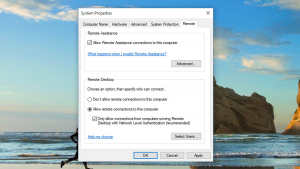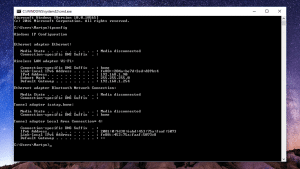<>
Remote Desktop Connection in Windows 10
Guide to use Remote Desktop Connection in Windows 10
It might be shocking to know that with the built-in tools in Windows, you can access files and control another computer remotely. We explain what you need to know about Remote Desktop Connection in Windows 10
Remote Desktop Connection in Windows 10
Although, you might find yourself sitting at one computer, but needing the data or facilities on another. Or you may need to help a friend or family member solve a problem. Well, with Remote Desktop Connection in Windows 10 you can access another PC in another room, or even on a Wi-Fi-enabled beach. We’ll show you how to set up this useful feature so you can control one PC using another.
How to use Remote Desktop Connection in Windows 10?
An answered question
In this post we will show you how these services also offer remote access to PCs. If all you want is to view files on your hard drive, or help out friends and relatives with remote support, then we’d definitely recommend these solutions as friendlier alternatives.
And with cloud storage being so affordable these days, not to mention cross platform, we’d also suggest that keeping your files on one of these services is an easier and more convenient way to access them that leaving your home PC on all the time just so you can get at its files. Even a NAS drive is a better solution.
There’s another problem with Remote Desktop Connection. Although all version of Windows 10 can connect to another Windows 10 PC remotely, only Windows 10 Pro allows remote access. So if you have Windows 10 Home edition, then you won’t find any settings to enable Remote Desktop Connection on your PC, but you will still be able to connect to another PC running Windows 10 Pro.
Ways to set up Remote Desktop Connection in Windows 10?
So, you have Windows 10 Pro and you really want to use RDC. Well, we did warn you, but here’s how to set it up.
First you have to allow remote access to your target PC.
To do this open File Explorer, find This PC and right-click and select Properties > Remote Settings.
In the Remote Desktop section make sure that the Allow remote connections to this computer option is selected and untick the Allow connections only from computers running Remote Desktop with Network Level Authentication, as it can complicate the setup process.
You can of course always return to it later to increase the security of your PC. Now click Apply and OK

Next, you’ll need to know the IP address of this target computer so that it can be found on the network.
To do this hold down the Windows key and press R. In the box that appears type cmd and press enter. In the terminal windows that appears type ipconfig and press enter.
You’ll see a range of information appear, but the one you want is IPv4 Address. Note this down (it’s a few numbers and full stops) and also write down the Default Gateway IP address.

The IPv4 address will allow you to access the PC on a local network, but if you want to access it from a WAN (ie if you’re at work and want to dial home) then open up a browser and in the address bar type in whatismyipaddress then make a note of the address.
Once you’ve set up the target PC to allow access and have the IP address, you can move to the remote computer.
On it, open the Start Menu, start typing “Remote Desktop” and select Remote Desktop Connection when it appears in the search results.
Then in the box that appear type the IP address and click Connect. You should be prompted for your username and password, then the PC should be available to you as if you were sitting in front of it.

<br />
<img class=”lightbox lz” src=”https://cdn2.techadvisor.co.uk/cmsdata/features/3632113/connection_box_thumb.png” alt=”How to use Remote Desktop Connection in Windows 10″ width=”750″ height=”421″ data-original-width=”1200″ data-original-height=”674″><br />
Can I connect to a PC over the internet?
Things are even more complicated if you want to access your PC that’s not on the same local network (LAN).
First, you’ll need to make sure the Windows firewall isn’t blocking Remote Desktop. You can check this by opening up the Windows Firewall section of the Control Panel and selecting Allow apps to communicate through Windows Firewall.
Next you’ll need to configure your router so that it knows the correct addresses for your computers (do this using the Default Gateway and WAN settings you wrote down previously), and enable the Port Forward setting so that it points at Port 3389. As router settings are different on every router, you should read our guide on How to forward ports on your router to make sense of it all.
(We did tell you this was complicated.)
It’s worth bearing in mind that if you intend to remotely connect to a PC like this on a regular basis, the external (WAN) IP address is subject to change. That’s because most broadband providers don’t give you a static IP address (i.e. the same one each time your router connects to your provider).
To avoid having to rediscover the address every time this happens, you can subscribe to a dynamic DNS service such as no-ip.com, as this gives you a memorable domain name to which you can connect, and will keep track of any changes to your external IP address. Many routers have built-in support for dynamic DNS, so have a look in your manual and select one of the services supported by your router.
With all of this completed you should now be able to open the Windows Start Menu, search for Remote Desktop, select Remote Desktop Connection, then in the box that appear type the IP address and click Connect. Enter your username and password, then you should have full access to the target PC.
remote desktop windows 10 home , windows 10 remote desktop over internet , windows 10 remote desktop client , windows 10 remote desktop app , remote desktop connection windows 10 download , windows 10 remote desktop not working ,windows 10 remote desktop missing , windows 10 remote assistance.
Now you know.
Lets hear you views in the comment box..
Discover more from Applygist Tech News
Subscribe to get the latest posts sent to your email.
